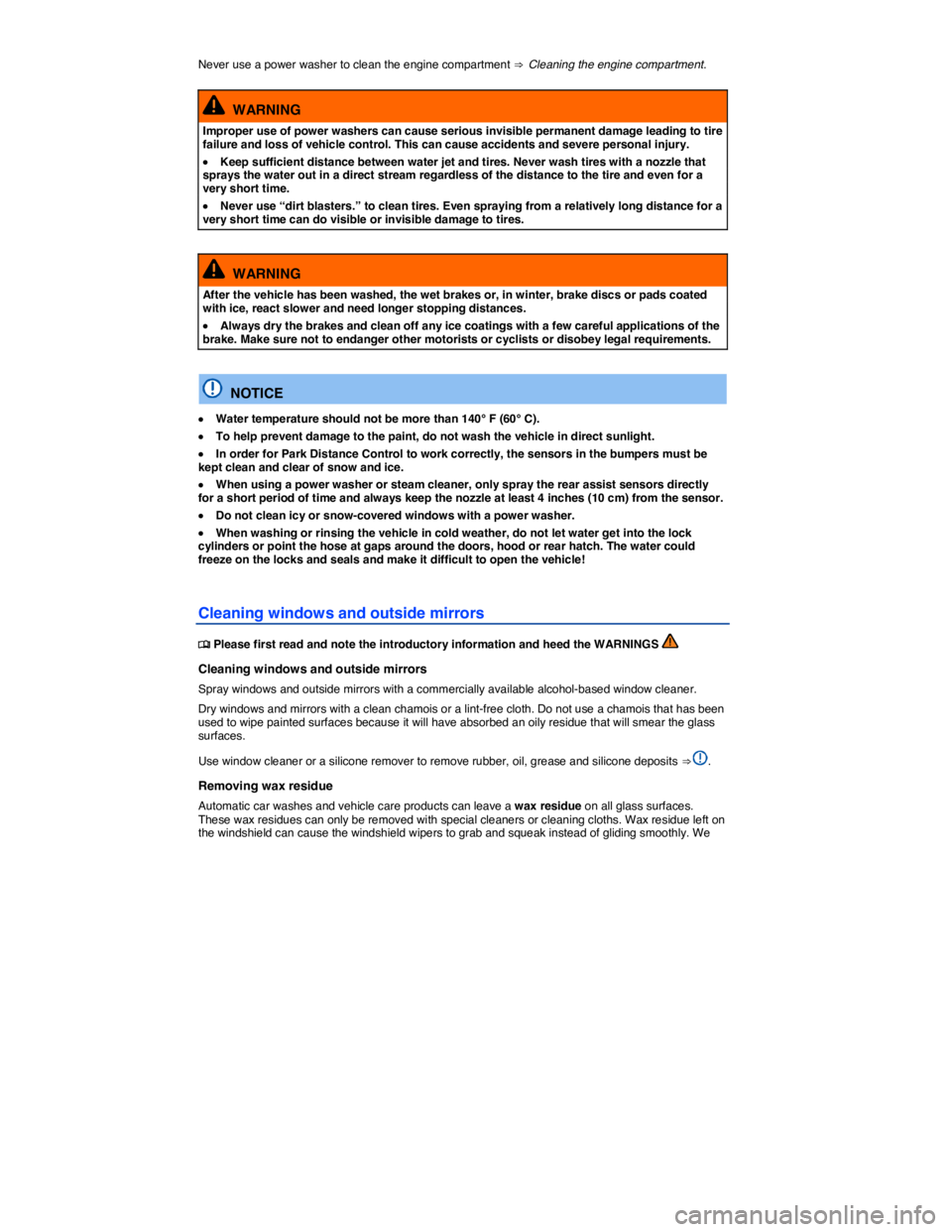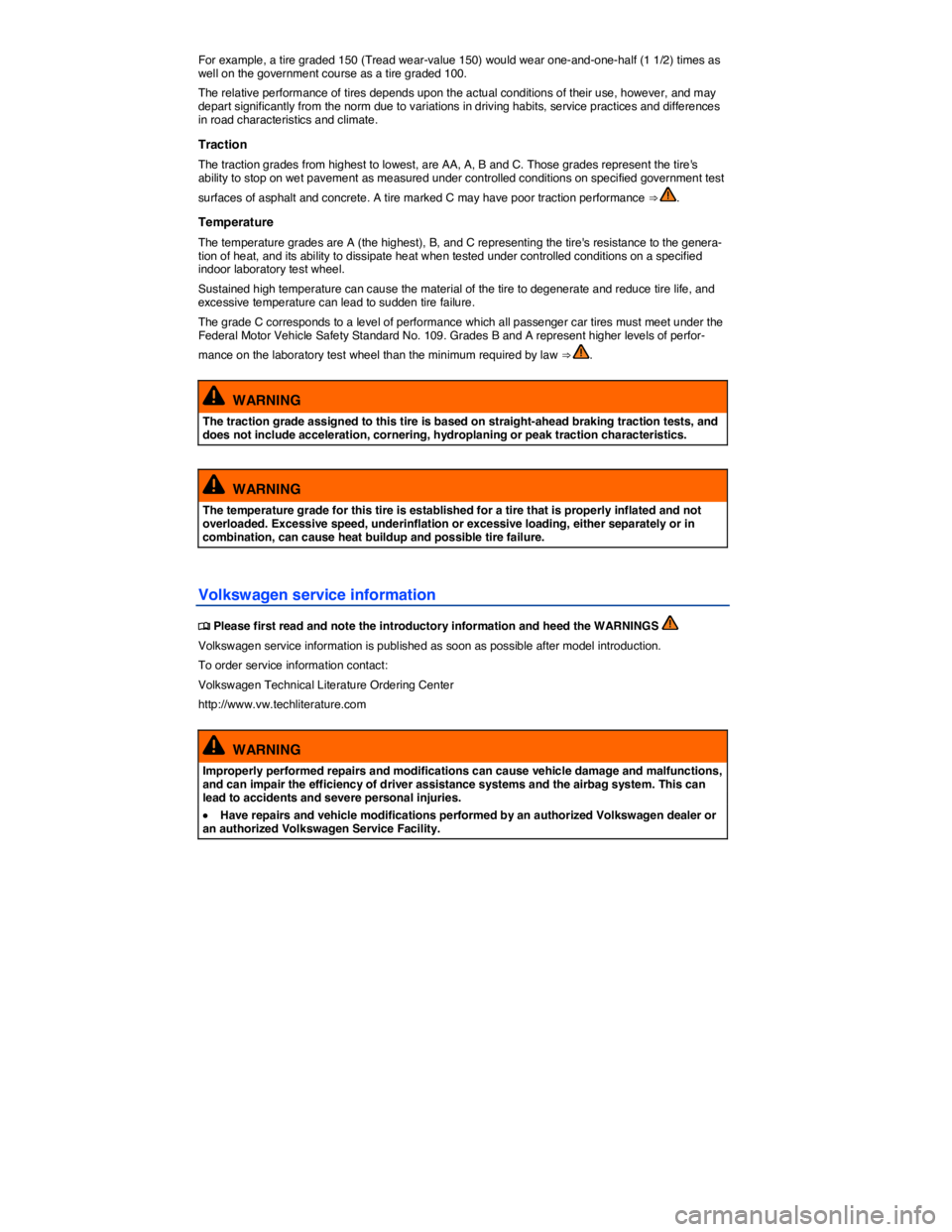2011 VOLKSWAGEN TOUAREG Temperature
[x] Cancel search: TemperaturePage 595 of 684

Never use a power washer to clean the engine compartment ⇒ Cleaning the engine compartment.
WARNING
Improper use of power washers can cause serious invisible permanent damage leading to tire failure and loss of vehicle control. This can cause accidents and severe personal injury.
�x Keep sufficient distance between water jet and tires. Never wash tires with a nozzle that sprays the water out in a direct stream regardless of the distance to the tire and even for a very short time.
�x Never use “dirt blasters.” to clean tires. Even spraying from a relatively long distance for a very short time can do visible or invisible damage to tires.
WARNING
After the vehicle has been washed, the wet brakes or, in winter, brake discs or pads coated with ice, react slower and need longer stopping distances.
�x Always dry the brakes and clean off any ice coatings with a few careful applications of the brake. Make sure not to endanger other motorists or cyclists or disobey legal requirements.
NOTICE
�x Water temperature should not be more than 140° F (60° C).
�x To help prevent damage to the paint, do not wash the vehicle in direct sunlight.
�x In order for Park Distance Control to work correctly, the sensors in the bumpers must be kept clean and clear of snow and ice.
�x When using a power washer or steam cleaner, only spray the rear assist sensors directly for a short period of time and always keep the nozzle at least 4 inches (10 cm) from the sensor.
�x Do not clean icy or snow-covered windows with a power washer.
�x When washing or rinsing the vehicle in cold weather, do not let water get into the lock cylinders or point the hose at gaps around the doors, hood or rear hatch. The water could freeze on the locks and seals and make it difficult to open the vehicle!
Cleaning windows and outside mirrors
�
Page 621 of 684

For example, a tire graded 150 (Tread wear-value 150) would wear one-and-one-half (1 1/2) times as well on the government course as a tire graded 100.
The relative performance of tires depends upon the actual conditions of their use, however, and may depart significantly from the norm due to variations in driving habits, service practices and differences in road characteristics and climate.
Traction
The traction grades from highest to lowest, are AA, A, B and C. Those grades represent the tire's ability to stop on wet pavement as measured under controlled conditions on specified government test
surfaces of asphalt and concrete. A tire marked C may have poor traction performance ⇒ .
Temperature
The temperature grades are A (the highest), B, and C representing the tire's resistance to the genera-tion of heat, and its ability to dissipate heat when tested under controlled conditions on a specified indoor laboratory test wheel.
Sustained high temperature can cause the material of the tire to degenerate and reduce tire life, and excessive temperature can lead to sudden tire failure.
The grade C corresponds to a level of performance which all passenger car tires must meet under the Federal Motor Vehicle Safety Standard No. 109. Grades B and A represent higher levels of perfor-
mance on the laboratory test wheel than the minimum required by law ⇒ .
WARNING
The traction grade assigned to this tire is based on straight-ahead braking traction tests, and does not include acceleration, cornering, hydroplaning or peak traction characteristics.
WARNING
The temperature grade for this tire is established for a tire that is properly inflated and not overloaded. Excessive speed, underinflation or excessive loading, either separately or in combination, can cause heat buildup and possible tire failure.
Volkswagen service information
�
Page 646 of 684

WARNING
Using the tire mobility set on the side of the road can be dangerous. To help reduce the risk of serious personal injury:
�x Always stop the vehicle as soon as it is safe to do so and move the vehicle a safe distance off the road where it is safe to use the tire mobility set.
�x Make sure that the ground is level and firm.
�x All passengers and especially children must stay a safe distance away from you while you are working and keep out of the area you are working in.
�x Turn on the emergency flasher and set up another warning device about 25 yards (25 meters) behind the vehicle to warn approaching traffic.
�x Use the tire mobility set only if you are familiar with the necessary steps. Otherwise, get expert assistance.
�x Use the tire mobility set only in emergencies and only until you can get professional help.
�x Immediately replace a tire repaired with the tire mobility set.
�x Sealant is harmful and must immediately be removed in case of skin contact.
�x Always store the tire mobility set out of reach of children.
�x Never use a vehicle jack, even if the jack is approved for use with your vehicle.
�x Always switch off the engine, engage the electronic parking brake, and shift the transmis-sion into Park (P) to reduce the risk that the vehicle will move unexpectedly.
WARNING
Improper use of the tire mobility set can cause a temporary tire to fail and lead to loss of vehicle control and serious personal injuries.
�x Always remember that a tire filled with sealant does not handle as well as an undamaged tire without sealant.
�x Never drive faster than 50 mph (80 km/h) with a sealed tire.
�x Never use the tire mobility set if the outside temperature is below –4 °F (–20 °C).
�x Never drive with a tire that has cuts or punctures, especially when they are larger than 3/16 in (4 mm).
�x Use the tire mobility set only for emergencies until you can get professional help.
�x If the tire cannot be inflated to at least 36 psi (2.5 bar), do not drive the vehicle. Contact the nearest authorized Volkswagen dealer, authorized Volkswagen Service Facility, or other qual-ified workshop.
�x If the tire inflation pressure drops below 26 psi (1.8 bar) after driving for 10 minutes, do not drive the vehicle any farther. Contact the nearest authorized Volkswagen dealer, author-ized Volkswagen Service Facility, or other qualified workshop.
�x Always replace a tire repaired with the tire mobility set immediately. Do not drive a tire that has been repaired with the tire mobility set longer or farther than is absolutely necessary.
�x Avoid full throttle acceleration, hard, braking, and fast cornering.
�x Drive at slow speed for 10 minutes. Then get out and check the air pressure and condition of the sealed tire.
Obey all legal requirements when disposing of used or expired sealant.
New tire inflation cylinders are available from authorized Volkswagen dealers and authorized Volkswagen Service Facilities.
Page 670 of 684

WARNING
Improper use of jumper cables when jump-starting a vehicle with a dead battery can cause the battery to explode, leading to serious personal injury. To help reduce the risk of battery explosion:
�x All work on the batteries or the electrical system in your vehicle can cause serious acid burns, fires, or electrical shocks. Always read and heed the following WARNINGS and safety
precautions before working on the batteries or the electrical system ⇒ 12 Volt vehicle bat-tery.
�x Always make sure that the battery providing starting assistance (the booster battery) has the same voltage as the dead battery (12 V) and about the same amperage capacity (see bat-tery label).
�x Never jump-start a vehicle with a thawed or frozen battery. The battery can explode. A dead battery can freeze at temperatures around +32 °F (0 °C).
�x A battery that is frozen or was frozen, but has since thawed, must be replaced.
�x When the vehicle battery is jump-started, it gives off hydrogen gas, which is highly explo-sive! Always keep fire, sparks, open flame, and smoking materials far away from vehicle bat-teries. Never use a cellular telephone while connecting or disconnecting jumper cables.
�x Jump-start batteries only in well-ventilated areas. Batteries give off highly explosive hy-drogen gas during jump-starting.
�x Always route the jumper cables so that they cannot get caught in any moving parts in the engine compartment.
�x Never short out the battery terminals by connecting the positive terminal (+) and negative (–) terminals with each other.
�x Never connect the negative cable from the other vehicle directly to the negative terminal of the dead battery, as this may cause the hydrogen gas given off by the dead battery to ex-plode.
�x Never attach the negative cable from the vehicle providing starting assistance to any part of the fuel system or to the brake hoses or brake lines.
�x Never allow the non-insulated parts of the battery clamps to touch.
�x Never allow the jumper cable attached to the positive battery terminal to contact metal parts of the vehicle.
�x Always follow the instructions of the jumper cable manufacturer.
NOTICE
To help prevent extensive damage to the vehicle electrical system, read and heed the follow-ing:
�x Connecting jumper cables improperly can cause a short circuit and do expensive damage to the vehicle's electrical system.
�x Do not let the vehicles touch each other while the jumper cables are connected. If they do, electrical current may flow between the vehicles when the positive (+) terminals are connected, causing electrical system damage.